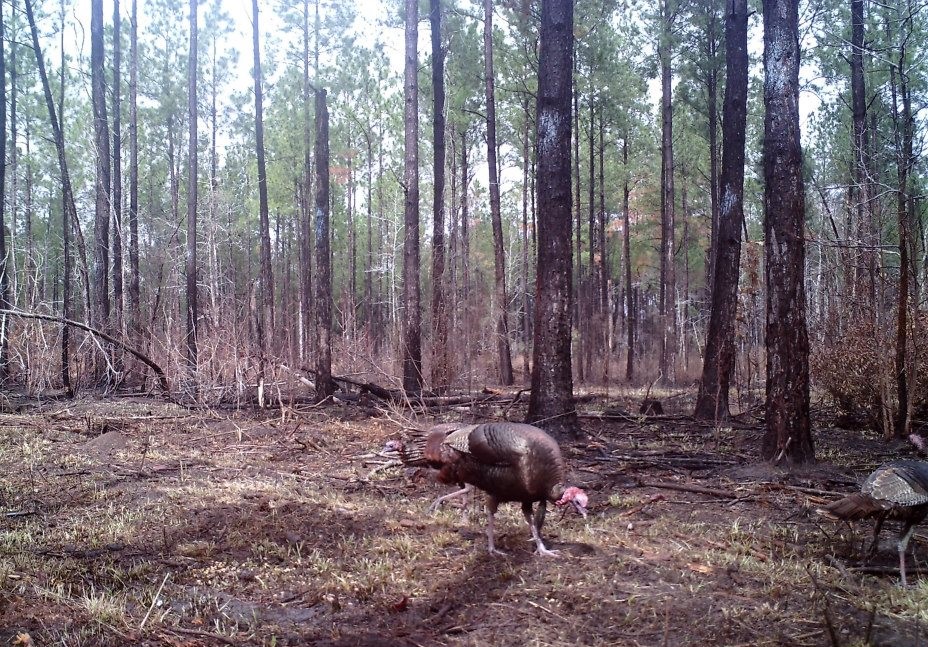
by Shep Eubanks | Nov 14, 2019
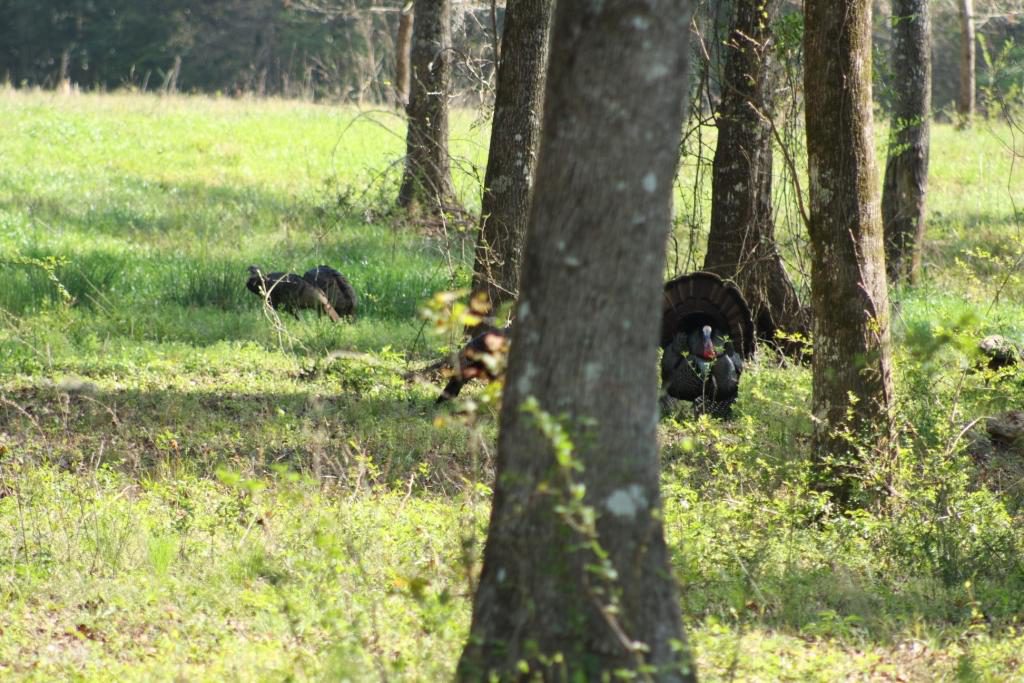
Eastern Wild Turkey Gobbler in Gadsden County – photo by Shep Eubanks UF/IFAS
The above picture of a strutting Eastern Wild Turkey is a sight that many hunters look forward to seeing every spring here in the panhandle of Florida. In order to manage wild turkeys and their habitat it is good to understand some basic facts about their biology.
Wild turkeys are considered a generalist species, meaning that they can eat a wide variety of foods, primarily seeds, insects, and vegetation. They prefer relatively open ground cover so that they can see well and easily move through their surroundings, but they aren’t picky about where they live as long as it provides them year-round groceries and safety. They are also a very adaptable species. Turkeys prefer low, moderately open herbaceous vegetation (less than three feet in height) that they can see through, or see over, and through which they can easily move in relatively close proximity to forested cover. Such open habitat conditions help them see and avoid predators and these areas will typically provide sufficient food in terms of edible plants, fruit, seeds, and insects.
Wild turkeys are considered, ecologically, to be a “prey species” and have evolved as a common food source for numerous animals—seems everything is trying to eat them. Turkey eggs, young (i.e.,poults), and adults are preyed on by such animals as bobcats, raccoons, skunks, opossum, fox , coyotes, armadillos, crows, owls, hawks, bald eagles, and a variety of snakes. Being prey to so many different animals has shaped the turkey’s biology and behavior. Turkeys experience high mortality rates and don’t live very long, on average, <2 years. They are particularly vulnerable during nesting and immediately after hatching. Because of this high mortality, reproduction is really important for turkey populations to replace the individuals that don’t survive from year to year. Wild turkeys have adapted to being a prey species in part, though, by having a high reproductive potential. Hens have the capacity to lay large clutches of eggs. If a nest is destroyed or disturbed, especially during the egg laying or early incubation period, the hen will often re-nest. Turkeys are also polygamous, with males capable of breeding multiple females, which further boosts their reproductive potential.
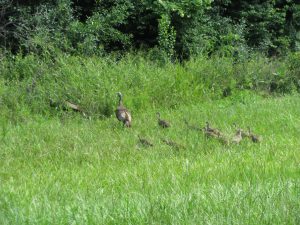
Turkey hen with poults foraging in a grassy field in Gadsden County – photo by Shep Eubanks UF/IFAS
Newly hatched turkeys, referred to as poults, need grassy, open areas so they can find an abundance of insects. Such areas are usually the most critical, and often the most lacking habitat in Florida. Under ideal conditions for turkeys, grassy openings would occupy approximately 25 percent of a turkey’s home range. Additionally, it is of equal importance to have such openings scattered throughout an area, varying in size from 1 to 20 acres such that they are small, or irregular in shape, to maximize the amount of adjacent escape cover (moderately dense vegetation or forested areas that can provide concealment from predators or other disturbances). Large, expansive openings (e.g., large pastures) without any escape cover are not as useful for turkeys since they generally will not venture more than 100 yards away from suitable cover.
Good habitat allows turkeys to SEE approaching danger and to MOVE unimpeded (either to move away from danger or simply to move freely while foraging without risk of ambush). In other words, good habitat provides the right vegetative structure. When thinking about habitat for turkeys, it’s good to always think from a turkey’s point of view….about 3 feet off the ground! Turkeys like open areas where they can see well and easily move.
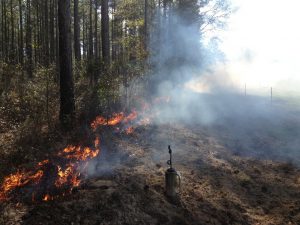
Burning pine land in Gadsden County to improve wild turkey habitat – photo by Shep Eubanks UF/IFAS
One of the best management techniques to manage vegetation structure and composition is prescribed fire. Fire can be very destructive, but if properly applied, fire can be quite beneficial to wildlife and is one of the best things you can do for wild turkeys. When applied correctly, fire has many benefits. Some of the benefits of fire to turkeys and other wildlife include: control of hardwood by setting back woody shrubs and trees in the under story; improving vegetation height and structure; stimulating new herbaceous growth at ground level; stimulating flowering and increased fruit production in some plants; it improves nutritional value and increases palatability of vegetation. All of this leads to increased insect abundance and fewer parasites in the environment. Prescribed fire also has benefits for the landowner. Applied properly and regularly, prescribed fire will reduce risk of catastrophic wildfire which can destroy a timber stand. It reduces hardwood competition so favored pines grow faster and healthier; and reduces the risk of disease, particularly after a thinning or timber cut, by removing logging debris that would otherwise attract insects and disease-causing agents. It can also help control invasive species, and best of all it’s the least expensive option on a cost per acre basis.
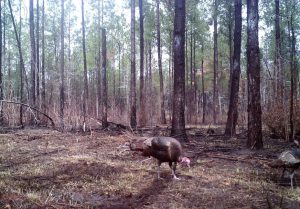
Gobblers in pine stand after burn – Game Camera photo by Shep Eubanks
Another good practice is simply mowing or bush-hogging. Even in areas that aren’t super thick (such as around forest and field edges, or seasonal wetlands), mowing and bush-hogging alone, even without fire, are beneficial as they have much the same effect on the habitat as fire. Basically, you’re removing grown up vegetation and allowing light to reach the ground again. Within pine plantations, roads often provide some of the best, or only, turkey habitat simply because the surrounding vegetation becomes too dense so roads are used for feeding and moving throughout the area. In this regard, wide roads increase the amount of open habitat which provides lots of insects, seeds, and edible vegetation. They also reduce the opportunity for predators to ambush turkeys which can readily occur on narrow roads. Having wide roads is a good land management practice that lets roads dry-out quicker so that they can hold up to traffic better.
If you have pine dominated timber stands on your property, proper thinning is not only good for turkeys, but it’s good for your stand. Young pine stands, particularly those in sapling or early pole stages, are often too thick for wild turkeys, except as escape cover. They get so dense that they shade out everything underneath. They may produce some pine seeds when they get older, but for most of the year, there’s nothing to eat and nothing to attract turkeys to the area. For turkeys, thinning opens up the canopy and allows sunlight to reach the forest floor, which in turn stimulates plant growth of grasses, forbs and soft-mast producing shrubs.
If you have an interest in turkeys, do most management activities outside of the nesting season, which generally runs from the middle of March through June. From a practical standpoint that is not always possible, so on the positive side, if a nest is destroyed (whether by predators or management efforts), a hen will quite often re-nest. Also, the overall importance of management will often outweigh the loss of 1 or 2 nests. The time that turkey nests are at a premium is when a turkey population is low or just trying to get established into an area. In such cases every nest is valuable.
For more information consult with your local Extension Agent .
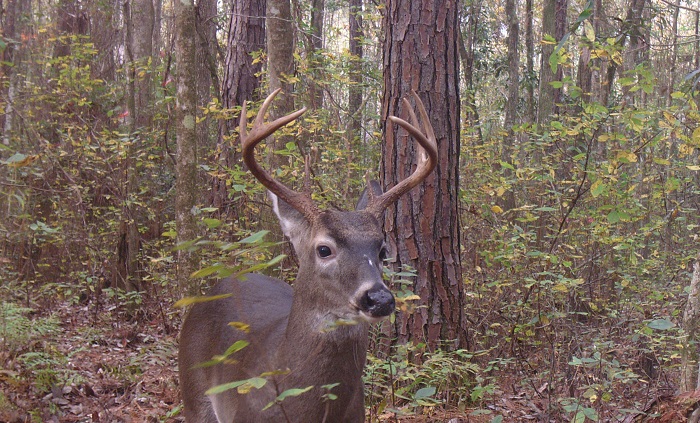
by Mark Mauldin | Nov 8, 2019

There are new regulations this season involving mandatory reporting of all deer harvested in Florida.
Photo Credit: Mark Mauldin
Deer hunting season here in Northwest Florida officially started this past Saturday (10/26) with the opening of archery and crossbow season; muzzleloading and general gun season will both open later this month. If you are fortunate enough to find success hunting in the woods, it is important that you remember substantial changes have gone into effect regarding the mandatory reporting of harvested deer. The following is a only a summary of some of the new regulations – complete official hunting regulations are available from the Florida Fish and Wildlife Conservation Commission.
The primary new regulation, put as simply as possible (again, this is only a summary):
All hunters must log their harvested deer prior to moving it from the point of harvest and report their harvested deer within 24 hours.
A hunter may log a harvested deer on a paper 2019-2020 Deer Harvest Log or via the FWC Deer Harvest Reporting App. The app allows a hunter to log and report a harvested deer, completing the process. If a hunter logs a deer on the paper form, they must also report the deer by calling 844-392-DEER (3337) between 8 a.m. – 8 p.m. ET or reporting online at MyFWC.com/HarvestReport. When successfully completed, either of these options, calling or going online, will result in a confirmation number. The confirmation number must be recorded on the Deer Harvest Log for the process to be complete. Note: using the app also generates a confirmation number that is automatically saved in the “sent” folder within the app. Follow the link for step-by-step instructions for using the FWC Deer Harvest Reporting App.
-
All harvested deer must be logged (on paper form or with the app) prior to being moved from where they were originally found.
-
All harvested deer must be reported (phone, online, or app) and confirmation number recorded on the paper log (or automatically on the app) within 24 hours of harvest**.
**Hunters must report harvested deer: 1) within 24 hours of harvest, or 2) prior to final processing of the deer, or 3) prior to the deer or any parts of the deer being transferred to a meat processor or taxidermist, or 4) prior to the deer leaving the state, whichever occurs first.
Hunters should be prepared to log and report harvested deer before they go hunting. They should have a copy of the 2019-2020 Deer Harvest Log with them, or have the FWC Deer Harvest Reporting App installed on their mobile device. In order to successfully log and report a harvested deer the hunter will also need the following information:
- Name (first and last name of the person who harvested the deer)
- Date of birth
- FWC Customer ID number (CID)
- Date of harvest
- Time of harvest
- Public or private land
- County
- Deer management unit
- Wildlife management area (if applicable)
- Method of harvest
- Antlered or antlerless deer
- Number of antler points (if antlered deer was indicated)
- Antlerless male or female (if antlerless deer was indicated)
- For deer taken on private lands, whether a deer program permit was used (Antlerless Deer Program permit or Private Lands Deer Management Program permit)
- 6-digit Tag number (if a deer program permit was used)
Another change for this hunting season is the establishment of the annual statewide bag limit of 5 deer per person of which no more than 2 deer can be antlerless.

FWC Deer Harvest Reporting APP
https://myfwc.com/hunting/deer/harvest-report/?redirect=harvestreport

FWC Deer Harvest Reporting Log
https://myfwc.com/media/21998/deer-harvest-log.pdf
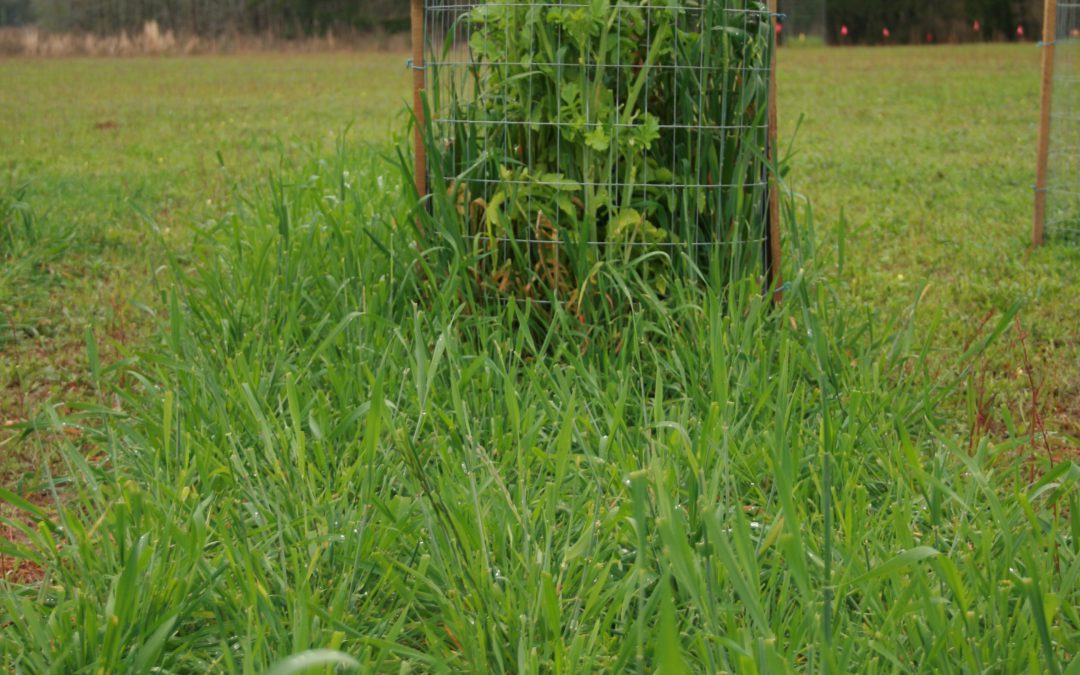
by Jennifer Bearden | Nov 8, 2019
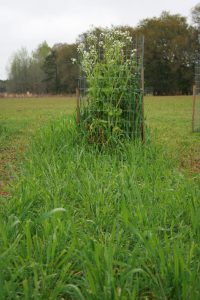
Daikon Radish and Buck Forage Oats Plot
When people put in food plots and are not successful, I normally see the following three problems as possible cause. First, they didn’t consider soil pH or fertility. Second, they didn’t choose the right plant varieties for our area. Third, they didn’t manage weeds properly or at all. So following these three steps can help establish a successful food plot.
- Soil pH and fertility
Often wildlife enthusiasts ignore soil pH and fertility. If the soil pH isn’t right, fertilization is a waste of time and money. Different plants have different needs. Some plants need more phosphorus than others. Some need more iron or zinc or copper. The availability of these elements not only depends on whether they are present in the soil but also on the soil pH. Test, Don’t Guess! It takes a week or two to get the full soil sample results back and costs only $10 per sample. That’s a pretty cheap investment to insure a successful food plot.
- Variety selection
Cool season food plots are generally used as attractants for hunters. It does provide some nutrition for the wildlife as well. The goal is to select forages that are desirable to the animals as well as varieties that grow well in our area. Some great choices include: oats, triticale, clovers, daikon radish and Austrian winter peas. We recommend a blend because it extends the length of time that forages are available to the animals as well as decreased risk of food plot failure. For a more information on recommended cool season forages, go to https://edis.ifas.ufl.edu/ag139.
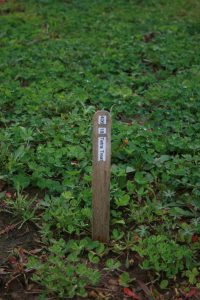
Tetra Treat Clover Mixture Plot
- Weed management
Often tilling the food plot prior to planting is enough to manage most weeds. This is okay when you have native weeds on relatively flat land. If erosion is an issue, or if more problematic weeds such as cogongrass are present, a different weed management strategy is recommended. Glyphosate is a good choice as it is a broad spectrum herbicide that will not negatively affect the food plot. Spray the area with glyphosate 3-4 weeks prior to planting to give it time to kill the weeds. Also, remember that many herbicides are not effective during droughts, so you either need to wait until we have rainfall or work with your extension agent to find a solution that will work for your situation.
These three steps are crucial to successful food plots. First, get your soil pH right and then fertilize properly. Next, choose the right forages and varieties to plant. Then control the weeds so they don’t choke out your food plots. The next step is to enjoy this hunting season. For more information on wildlife food plots, you can contact your local county extension agent.
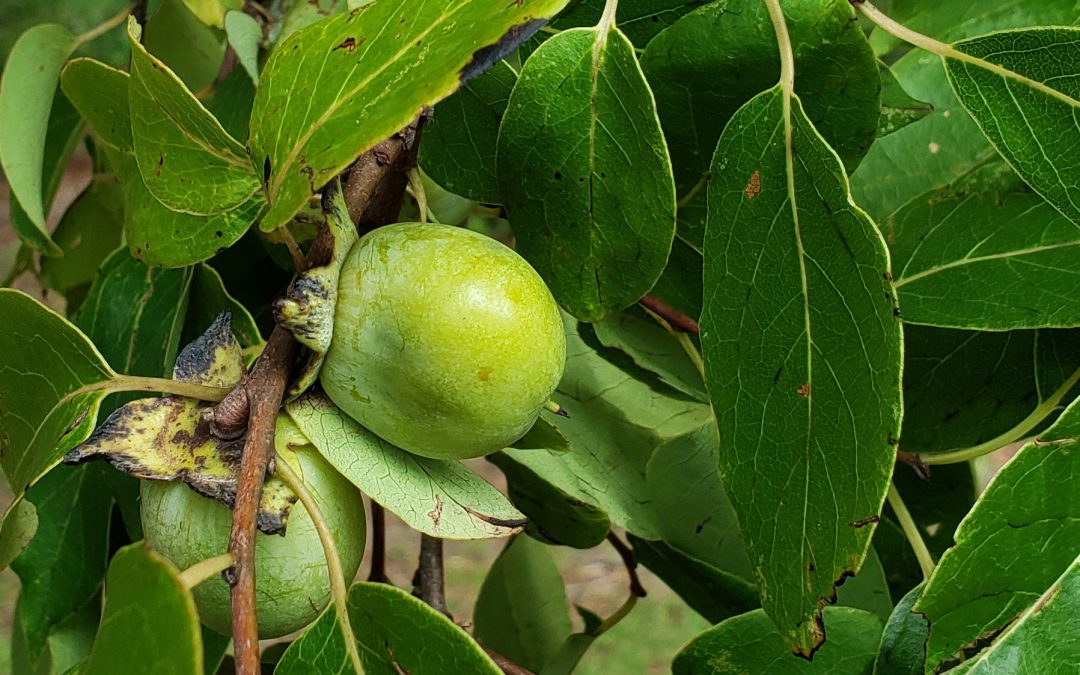
by Mark Mauldin | Oct 10, 2019
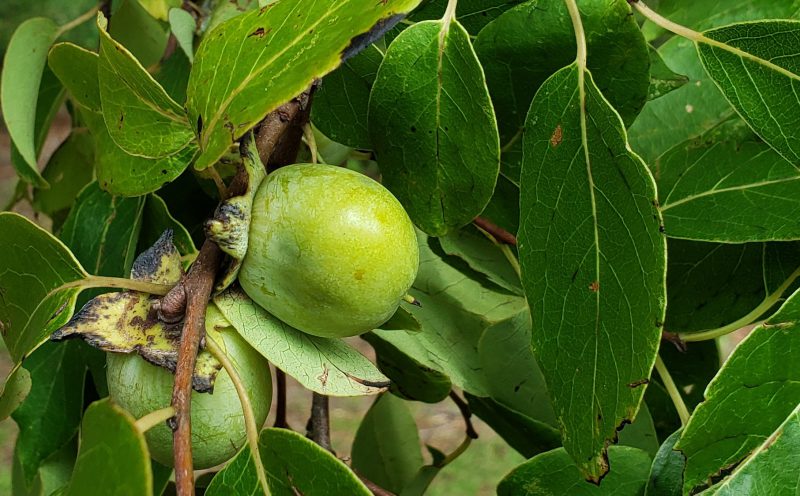
Protecting and promoting plants that produce soft mast, like this wild persimmon, can be a crucial step in improving wildlife habitat. Note: This time of year persimmons will be orange, the picture was taken earlier in the summer.
Photo Credit: Mark Mauldin
Landowners frequently prioritize wildlife abundance and diversity in their management goals. This is often related to a desired recreational activity (hunting, bird watching, etc.).
In order to successfully meet wildlife related management goals, landowners need to understand that animals frequent specific areas based largely on the quantity, quality and diversity of the food and cover resources available. Implementing management strategies that improve wildlife habitat will lead to greater wildlife abundance and diversity.
Herbivorous wildlife feed on plants, mostly in the form of forages and mast crops. All wildlife species have preferences in terms of habitat, especially food sources. Identifying these preferences and managing habitat to meet them will promote the abundance of the desired species.
Herbaceous plants, leaves, buds, etc. – serve as forages for many wildlife species. Promoting their growth and diversity is essential for improving wildlife habitat. Three common habitat management practices that promote forage growth include:
1) Create forest openings and edges; forested areas with multiple species and/or stand ages, areas left unforested allowing for increased herbaceous plant growth.
2) Thinning; open forest canopy allowing more light to hit the ground increasing herbaceous plant growth and diversity.
3) Prescribed fire; recycle nutrients, greatly improve the nutritional quality of herbage and browse, suppress woody understory growth.
Mast – the seeds and fruits of trees and shrubs – is often one of the most important wildlife food sources on a property.
Hard mast includes shelled seeds, like acorns and hickory nuts and is generally produced in the fall and serves as a wildlife food source during the winter.
Soft mast includes fruits, like blackberries and persimmons, and is generally produced in the warmer months, providing vital nutrition when wildlife species are reproducing and/or migrating.
Making management decisions that protect and promote mast producing trees will encourage wildlife populations.
Landowners can make supplemental plantings to increase the quantity and quality of the nutrition available to wildlife. These supplemental plantings (food plots/forage crops and mast producing trees) can be quite expensive and should be well planned to help maximize the return on investment.
Key points to remember to help ensure the success of supplemental wildlife plantings.
- Select species/varieties that are well adapted to the site.
- Take soil samples and make recommended soil amendments prior to planting.
- Make plantings in areas already frequented by wildlife (edges, openings, etc.).
- Food plots should be between 1 and 5 acres. Long, narrow designs that maximize proximity to cover are generally more effective.
Habitat management and other wildlife related topics are being featured this year in the UF/IFAS building at the Sunbelt Ag Expo. Make plans to attend “North America’s Premiere Farm Show” and stop by the UF/IFAS building, get some peanuts and orange juice and learn more about Florida’s Wildlife.
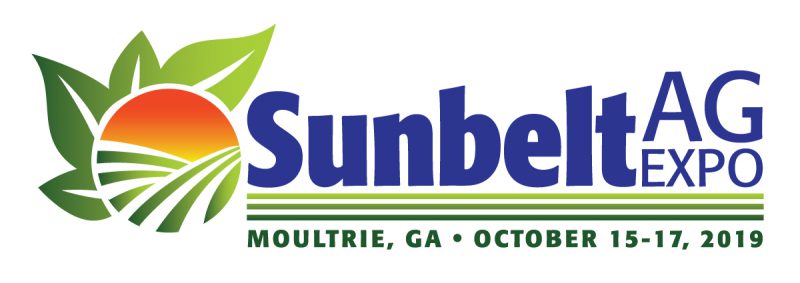 If you have any questions about the topics mentioned above, contact your county’s UF/IFAS Extension Office or check out the additional articles listed on the page linked below.
If you have any questions about the topics mentioned above, contact your county’s UF/IFAS Extension Office or check out the additional articles listed on the page linked below.
EDIS – Wildlife Forages
A significant portion of this article was summarized from Establishing and Maintaining Wildlife Food Sources by Chris Demers et al.
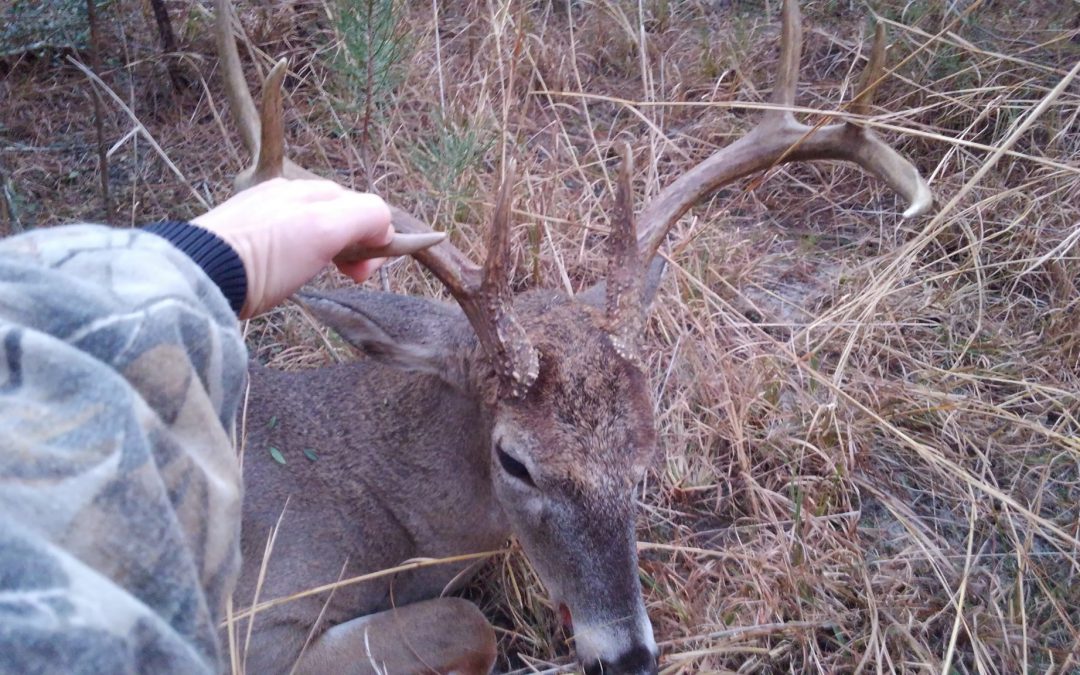
by Jennifer Bearden | Jan 31, 2019
This time of year in Northwest Florida, deer hunters are busy talking about the rut! What’s the rut, you might ask? Simply put, it’s deer breeding season. Deer hunters speculate on peak rut times each year. There are even peak rut forecasts. Why are hunters interested in deer rut? Hunters know that bucks are more active and careless during the rut.
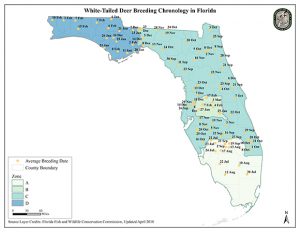
Deer Breeding Chronology in Florida May 2018. Source Florida Fish and Wildlife Commission
Bucks exhibit four rut behaviors: sparring, rubbing, scraping, and chasing. Sparring happens between bucks to establish dominance. This happens during the pre-rut. Dominant bucks are generally the ones who get the does. Bucks also make rubs on trees during the pre-rut period. They start this behavior to remove velvet from their antlers. They continue rubbing to mark their territory with their scent. Scraping is another way they mark their area. A scrape normally occurs under a low hanging branch. The buck will lick or chew on the branch while scraping the ground as well as urinating on the ground. The last rut behavior is chasing does. Does typically won’t be game for this unless they are ready to breed.
In other parts of the country, the rut is long over. Even in other parts of Florida, it is over. Florida has more variability in rut timing than in any other state. In Florida, deer rut starts in July in the southern part of the state and runs through February in the north. Deer breeding dates are more predictable in the northern U.S. where winters are too harsh for fawn survival. Deer breeding in our state is more variable because of our mild winters. Average breeding dates in Northwest Florida are very late compared to other parts of the country and the state. Our average breeding dates generally range from December to mid-February. Gestation takes about 200 days, so this puts fawning dates in late June through early September.
Even though we have average breeding dates for our area, these aren’t “magical dates”. Not all does go into estrus on the same day or even the same week.
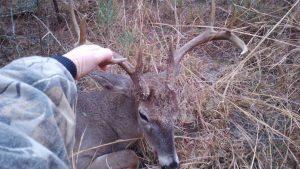
8 point buck taken in Northwest Florida in January while chasing a doe. Photo credit: Jennifer Bearden
Estrus only lasts 24 hours and not all does become pregnant during the first estrus period. This means that about 28 days later does go into a second estrus. So the rut period is a range around the average date.
So, to all my fellow hunters in Northwest Florida, enjoy the 2019 rut! I know I have enjoyed watching several bucks chase does as well as having the opportunity to take the biggest buck of my life this January. Good luck to you all in your hunting ventures!
More information about the Florida Fish and Wildlife Commission Deer Breeding Chronology Study can be found at https://myfwc.com/hunting/deer/.
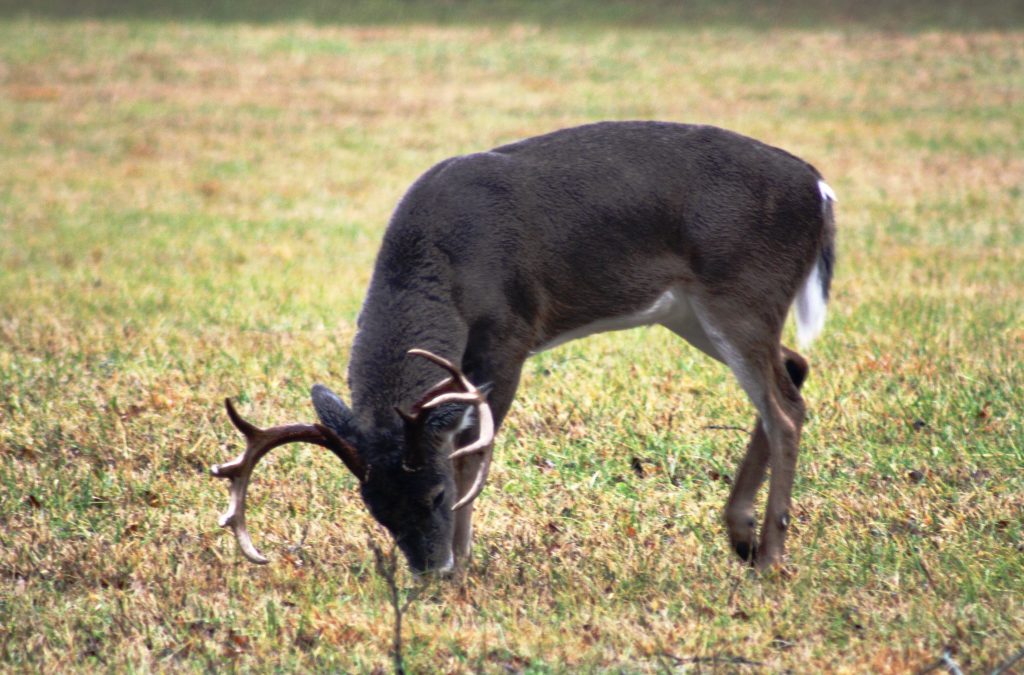
by Shep Eubanks | Sep 12, 2018
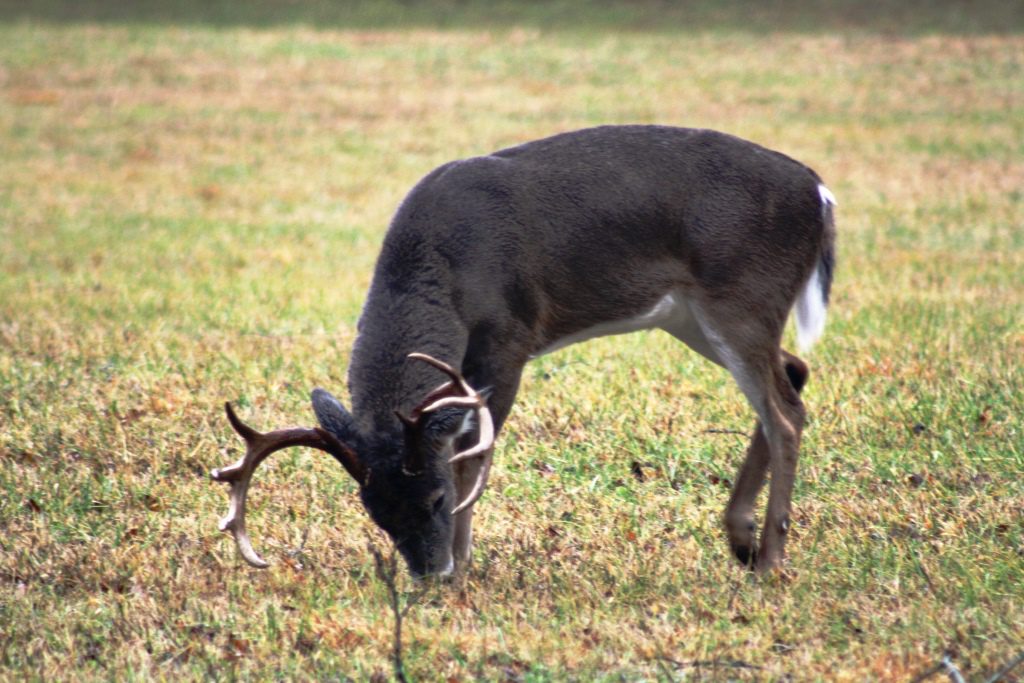
North Florida buck feeding on acorns at the edge of a food plot. Photo Credit – Shep Eubanks UF/IFAS
It’s that time of year when landowners, hunters, and other wildlife enthusiasts begin to plan and prepare fall and winter food plots to attract wildlife like the nice buck in the photo.
Annual food plots are expensive and labor intensive to plant every year and with that thought in mind, an option you may want to consider is planting mast producing crops around your property to improve your wildlife habitat. Mast producing species are of two types of species, “hard mast” (oaks, chestnut, hickory, chinkapin, American Beech, etc.), and “soft mast” (crabapple, persimmon, grape, apple, blackberry, pears, plums, pawpaws, etc.). There are many mast producing trees and shrubs that can be utilized and will provide food and cover for a variety of wildlife species. This article will focus on two, sawtooth oak (or other oaks) and southern crabapple.
Sawtooth Oak
Oaks are of tremendous importance to wildlife and there are dozens of species in the United States. In many areas acorns comprise 25 to 50% of a wild turkeys diet in the fall (see photos 1, 2, and 3) and probably 50% of the whitetail deer diet as well during fall and winter. White oak acorns average around 6% crude protein versus 4.5% to 5% in red oak acorns. These acorns are also around 50% carbohydrates and 4% fat for white oak and 6% fat for red oak.
The Sawtooth Oak is in the Red Oak family and typically produces acorns annually once they are mature. The acorns are comparable to white oak acorns in terms of deer preference as compared to many other red oak species. Most red oak acorns are high in tannins reducing palatability but this does not seem to hold true for sawtooth oak. They are a very quick maturing species and will normally begin bearing around 8 years of age. The acorn production at maturity is prolific as you can see in the photo and can reach over 1,000 pounds per tree in a good year when fully mature. They can reach a mature height of 50 to 70 feet. There are two varieties of sawtooth oak, the original sawtooth and the Gobbler sawtooth oak, which has a smaller acorn that is better suited for wild turkeys. The average lifespan of the sawtooth oak is about 50 years
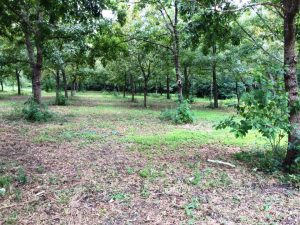
Photo 1 – Seventeen year old planting of sawtooth oaks in Gadsden County Florida. Photo Credit – Shep Eubanks UF/IFAS
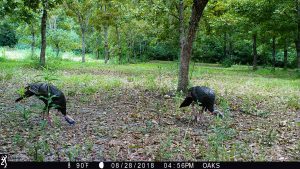
Photo 2 – Gadsden County gobblers feeding on Gobbler sawtooth oak acorns
Photo Credit – Shep Eubanks UF/IFAS
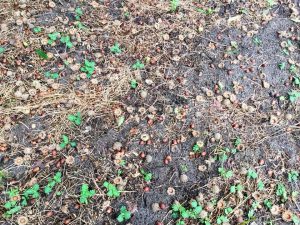
Photo 3 – Gobbler sawtooth oak acorns in Gadsden County. Notice the smaller size compared to the regular sawtooth oak acorn which is the size of a white oak acorn.
Photo credit – Shep Eubanks UF/IFAS
Southern Crabapple
Southern Crabapple is one of 25 species of the genus Malus that includes apples. They generally are well adapted to well drained but moist soils and medium to heavy soil types. They will grow best in a pH range of 5.5 – 6.5 and prefer full sun but will grow in partial shade as can be seen in photo 4. They are very easy to establish and produce beautiful blooms in March and April in our area as seen in photo 5. There are many other varieties of crabapples such as Dolgo that are available on the market in addition to southern and will probably work very well in north Florida. The fruit on southern crabapple is typically yellow green to green and average 1 to 1.5 inches in diameter. They are relished by deer and normally fall from the tree in early October.
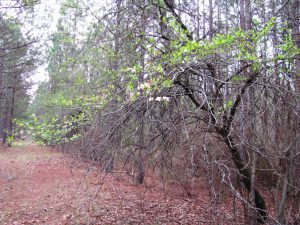
Photo 4 – Southern crabapple tree planted on edge of pine plantation stand. Photo taken in late March during bloom.
Photo credit – Shep Eubanks UF/IFAS
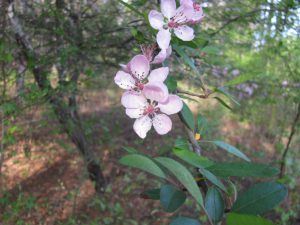
Photo 5 – Showy light pink to white bloom of southern crabapple in early April during bloom.
Photo credit – Shep Eubanks UF/IFAS
A good resource publication on general principles related o this topic is Establishing and Maintaining Wildlife Food Sources.
If you are interested in planting traditional fall food plots check out this excellent article by UF/IFAS Washingon Couny Extension Agent Mark Mauldin: Now’s the Time to Start Preparing for Cool-Season Food Plots .
For more information on getting started with food plots in your county contact your county’s UF/IFAS Extension Office
























